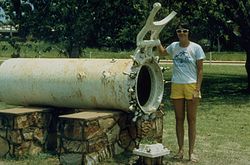

Pearling in Western Australia includes the harvesting and farming of both pearls and pearl shells (for mother of pearl) along the north-western coast of Western Australia.
The practice of collecting pearl shells existed well before British settlement. After settlement, Aboriginal people were used as slave labour in the emerging commercial industry, a practice known as blackbirding.[1][2] After 1886, with the rise of 'hard hat' diving, Asian divers from coastal and island regions became most common, leading to the pearling industry being the sole exception to the White Australia Policy of 1901.[3]: 146
Pearling centred first around Nickol Bay and Exmouth Gulf and then around Broome, to become the largest in the world by 1910.[clarification needed] The farming of cultured pearls remains an important part of the Kimberley economy, worth A$67 million in 2014 and is the second largest fisheries industry in Western Australia after rock lobster.[4]
- ^ Collins, Ben (9 September 2018). "Reconciling the dark history of slavery and murder in Australian pearling, points to a brighter future". ABC News. Australian Broadcasting Corporation. Retrieved 6 March 2020.
- ^ "Early Years". ebroome.com. Archived from the original on 17 July 2006. Retrieved 29 September 2006.
- ^ Nayton, Gaye (2011). The archaeology of market capitalism: a Western Australian perspective. New York: Springer. ISBN 978-1-4419-8318-3.
- ^ "Pearling". Department of Primary Industries and Regional Development. Government of Western Australia. 6 September 2017. Archived from the original on 12 March 2020. Retrieved 29 March 2020.
